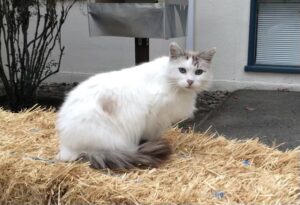
“It makes these little houses,” Mills senior Izzy Campise explained as she demonstrated her crochet box stitch. While some crafters may find knitting more approachable, Campise has always gravitated toward crocheting, opting to work with a single needle in her deft hands as she loops yarn in a mesmerizing pattern.
The box stitch is easy to do, which makes this form of crafting the perfect kinetic activity to combat the confinement of pandemic life.
“When I was on Zoom, and doing Zoom school and having to sit all the time, that’s when I started to crochet,” Campise said. “My professors would want us to keep our cameras on but we couldn’t walk around because it was distracting. So I needed a way to fiddle. That was what started me crocheting again, the need to move physically and not really being able to.”
Campise learned to crochet as a child. Having picked up the craft again, she has found it soothing and helpful as a student.
“I think overall, I’ve become a better note taker because of it,” she said. “Because I’m not just sitting there trying to write every single thing that my teacher is saying. I’m having to listen with intention because I get stubborn and don’t want to stop crocheting to write.”
Before the pandemic, Campise was in constant motion as an athlete, whether dancing, doing martial arts, or walking 15 miles a day as a nanny in San Francisco. When her martial arts and dance studios shut down, she turned to art as an outlet.
She found that drawing and painting demanded too much attention, so she switched to crocheting; something she could do mindlessly, yet imbue with her own sense of aesthetics and her desire to do good for others.
Last semester, Campise knit about 25 scarves, which she donated to a homeless shelter. When scarves began to seem tedious, she decided to make blankets.
“I had never made anything that big before,” she said. “So I was like, well, it can’t be that hard given that it’s like a really big scarf. You just keep going. And then I ended up making a blanket that was the size of a queen bed.”
Making and giving away blankets became a way for Campise to connect with loved ones during the pandemic.
“I’ve been distributing them to friends and family,” she said. “It’s a way to try to still have some form of human contact and intimacy and still be COVID safe.”
Campise’s blankets hold important meaning for both her and her recipients, and allow her to give them some of the “human touch” missing during COVID.
“Blankets are sort of intimate things, right? Like, they’re something you put on your body, that you wrap around yourself,” she said. “So, you know, at a time where you can’t go and hug your friends, to give them a blanket and be like, you know, wrap this around yourself when you’re feeling lonely, it’s kind of like giving a hug without touching someone.”
After hearing about a COVID-themed exhibit at the Lawrence Hall of Science, Campise decided to submit one of her crocheted blankets.
“It’s [the blanket] with other things that people have made. And I think that’s really cool,” she said. “I think it’s sort of sweet to get to see what people were doing with their time. And there were some wacky creatures that people made and some really interesting gadgets.”
Campise wanted to help create a sense of community by sharing her art in the exhibit.
“I wanted my blankets to sort of be a way to have community when you can’t have community and I feel like that’s just an extension of this, right,” she said, of the exhibit. “It’s like I’m putting my blanket into a larger context, in a community when people are being forced to keep apart.”
Campise’s interest in community art started at Berkeley City College, where she took a mural painting course and participated in a public art project near Ashby BART. Having her work in a public space gave Campise confidence, to which she attributes the desire to participate in the Lawrence Hall of Science exhibit.
Growing up in an artistic family that owns a tattoo studio in Berkeley, Campise felt both inspired and daunted by the artistic precedent set by her own family.
“I think this project did make me think that I was more capable of doing art that could be on display, because I’m growing up in a community of artists, there’s a lot of beauty in that. But it’s also very intimidating, like, as someone who wants to make art, but maybe that’s not their medium,” she said. “It can be very intimidating to be surrounded by people who are professional artists who are making money off of that, and who are very skilled in their craft.”
In the future, Campise hopes to do more community-based art, and expects to continue to be inspired by friends, family and other artists.
“I like the idea of art with social justice or community engagement,” she said. “So I hope to incorporate that into my life.”

